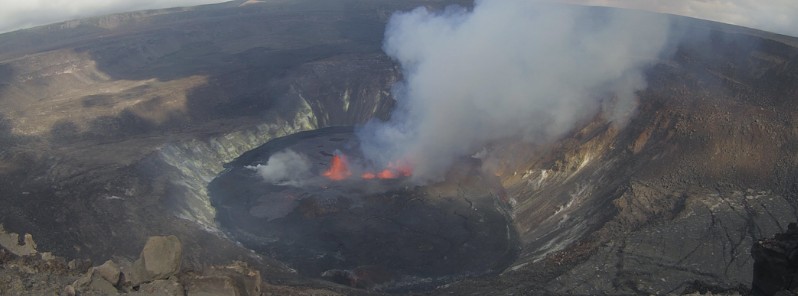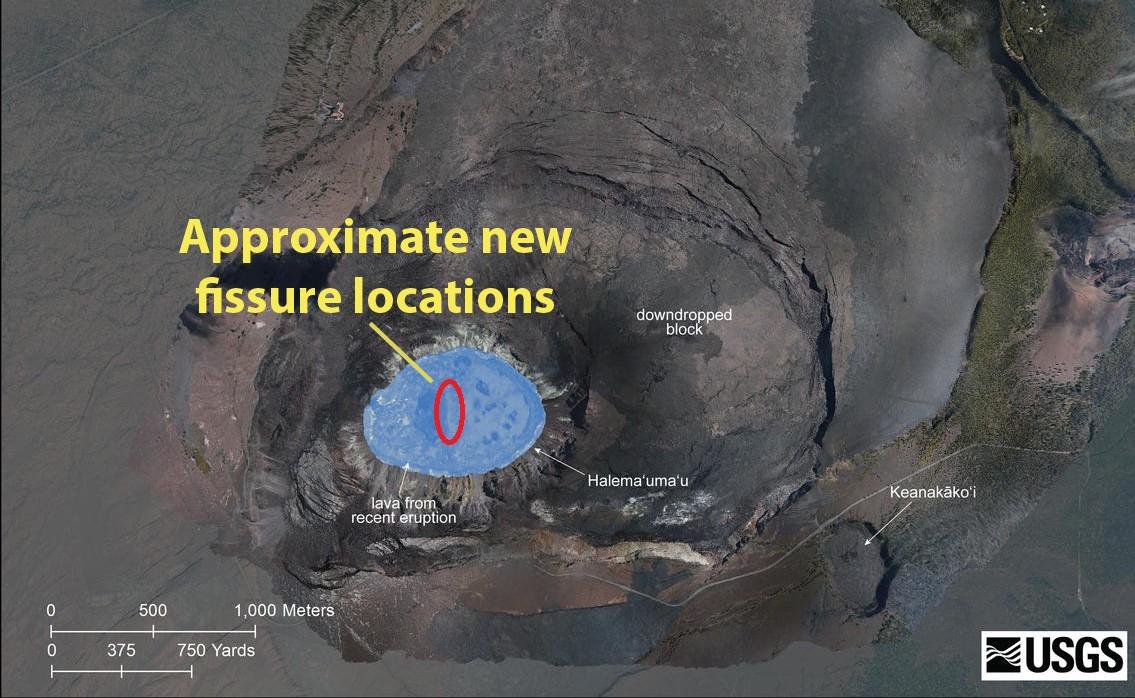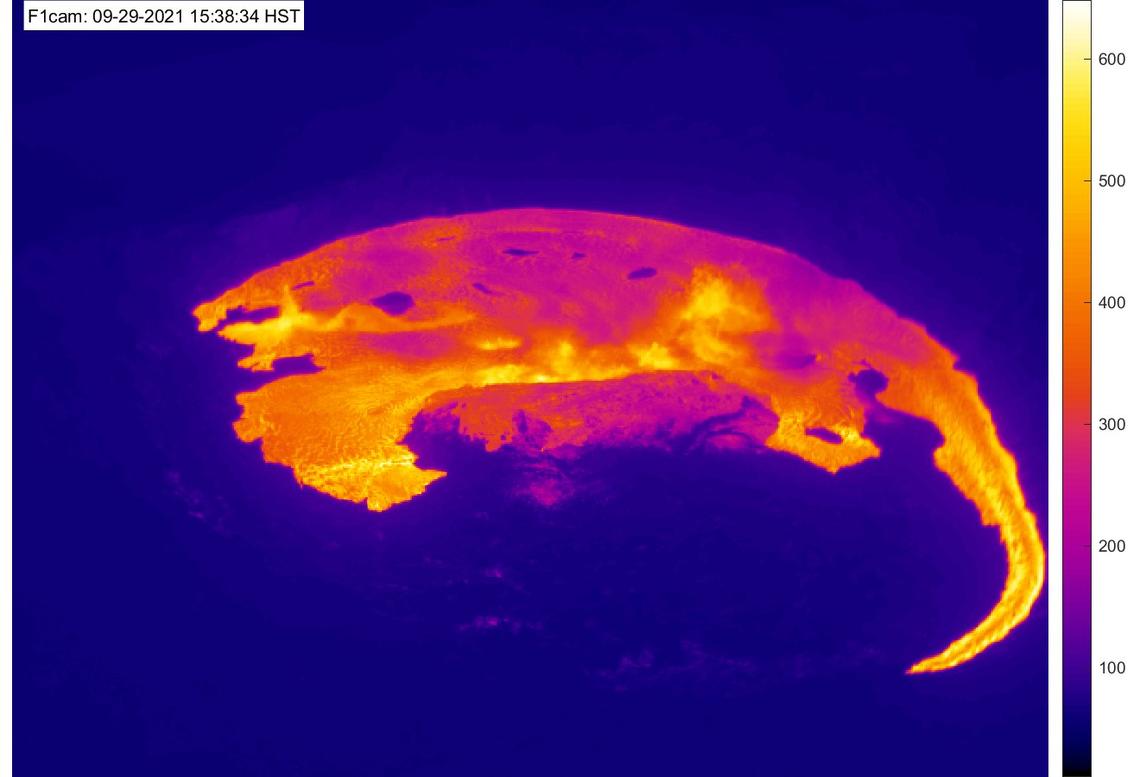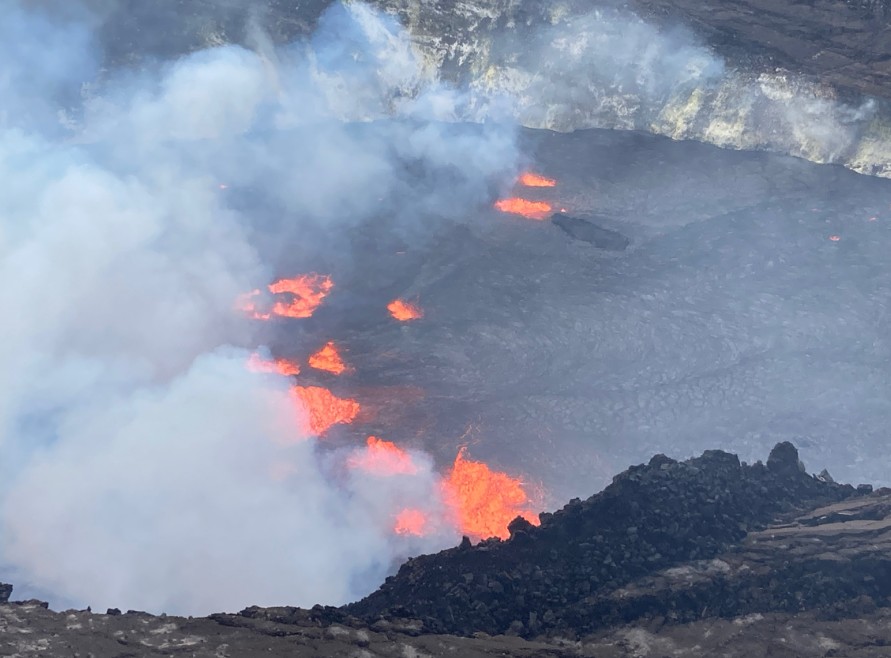New eruption at Kilauea volcano, Aviation Color Code raised to Red, Hawaii

A new eruption began at Kilauea volcano’s Halema‘uma‘u crater at approximately 01:20 UTC on September 30, 2021 (15:20 HST, September 29). As a result, the USGS Hawaiian Volcano Observatory (HVO) raised the Volcano Alert Level for ground-based hazards from ADVISORY to WARNING and the Aviation Color Code from YELLOW to RED.
A swarm of earthquakes began beneath the south part of Kilauea caldera, Hawaii on August 24, 2021, with a particularly strong sequence that occurred at about 11:30 UTC.1
Increased earthquake activity and changes in the patterns of ground deformation at Kilauea’s summit began again at approximately 22:00 UTC on September 29, indicating the movement of magma in the subsurface.
At approximately 01:20 UTC on September 30, HVO detected a glow in Kīlauea summit webcam images indicating that an eruption has commenced within Halemaʻumaʻu crater.2


Image credit: USGS/HVO, M. Patrick
Webcam imagery shows fissures at the base of Halemaʻumaʻu crater generating lava flows on the surface of the lava lake that was active until May 2021.
The activity is confined to Halemaʻumaʻu and the hazards will be reassessed as the eruption progresses.
The opening phases of eruptions are dynamic and uncertain, HVO said, adding that it continues to monitor the volcano closely and will report any significant changes.


Image credit: USGS/HVO


Image credit: USGS/HVO
Hazard analysis
This new eruption at Kīlauea’s summit is occurring within a closed area of Hawai’i Volcanoes National Park, HVO said.2
Therefore, high levels of volcanic gas are the primary hazard of concern, as this hazard can have far-reaching effects downwind. Large amounts of volcanic gas – primarily water vapor (H2O), carbon dioxide (CO2), and sulfur dioxide (SO2) – are continuously released during eruptions at Kīlauea.
As SO2 is released from the summit, it will react in the atmosphere to create the visible haze known as vog (volcanic smog) that has been observed downwind of Kīlauea.
Vog creates the potential for airborne health hazards to residents and visitors, damages agricultural crops and other plants, and affects livestock.
Additional hazards include Pele’s hair and other lightweight volcanic glass fragments from the lava fountains that will fall downwind of the fissure vents and dust the ground within a few hundred meters of the vent(s). Strong winds may waft lighter particles to greater distances. Residents should minimize exposure to these volcanic particles, which can cause skin and eye irritation.
Other significant hazards also remain around Kīlauea caldera from Halemaʻumaʻu crater wall instability, ground cracking, and rockfalls that can be enhanced by earthquakes within the area closed to the public.
This underscores the extremely hazardous nature of Kīlauea caldera rim surrounding Halemaʻumaʻu crater, an area that has been closed to the public since late 2007.
Geological summary
Kilauea volcano, which overlaps the east flank of the massive Mauna Loa shield volcano, has been Hawaii’s most active volcano during historical time.
Eruptions of Kilauea are prominent in Polynesian legends; written documentation extending back to only 1820 records frequent summit and flank lava flow eruptions that were interspersed with periods of long-term lava lake activity that lasted until 1924 at Halemaumau crater, within the summit caldera.
The 3 x 5 km (1.9 x 3.1 miles) caldera was formed in several stages about 1500 years ago and during the 18th century; eruptions have also originated from the lengthy East and SW rift zones, which extend to the sea on both sides of the volcano.
About 90% of the surface of the basaltic shield volcano is formed of lava flows less than about 1 100 years old; 70% of the volcano’s surface is younger than 600 years.
A long-term eruption from the East rift zone that began in 1983 has produced lava flows covering more than 100 km2 (37 mi2), destroying nearly 200 houses and adding new coastline to the island.3
References:
1 Strong earthquake swarm under Kilauea, Alert Level raised to Watch, Hawaii – The Watchers
2 HVO/USGS Volcanic Activity Notice Volcano: Kilauea (VNUM #332010) – September 23, 2021 (UTC)
3 Kilauea – Geological summary – GVP
Featured image credit: USGS/HVO

All hot spot volcanoes will erupt and not only Yellowstone. The reason has to do with the energy increase at the interior of the Earth. However, this fact is not accepted and can never be accepted by mainstream science.
So how much in the near future do you see Yellowstone blowing its top?
If earth changes are happening faster and faster why do we not see an increase in hurricane strength, numbers and landfall in the Atlantic seaboard of the USA?
Kilauea erupted before this summer, I watched the update videos every day, it was parallel with the eruption in Iceland. Everywhere the news is trying to bury that eruption with north and south-east vents on the Kilauea caldera, same as it is now.
I COME TO BE CORRECT, WHILE THE USGS IS WRONG……… Last year when Kilauea volcano settled down after its eruption in December 20, 2020 the US Geological Survey Said, it will not erupt again in the near future. However, I was insisting that it will erupt again in a very short span of time. Now, I come out to be right and the USGS is wrong. And, the same thing will happen in the case of Yellowstone Super-volcano. The USGS has said and still saying it will not erupt in foreseeable future, while I am arguing it will erupt very, very soon. Keep in mind that Yellowstone is a hot spot volcano, just like Kilauea, Cumbre Vieja volcano and Fagradalsfjall volcano
Global warming, the Intergovernmental Panel on Climate Change is correct. Do you know that the rapid shifting of Earth’s magnetic field is caused by global warming? It has happened many times in the last a few billions years. For instance, the methane released by dinosaurs (dinosaurs farting) caused their extinction, hahahahahaha